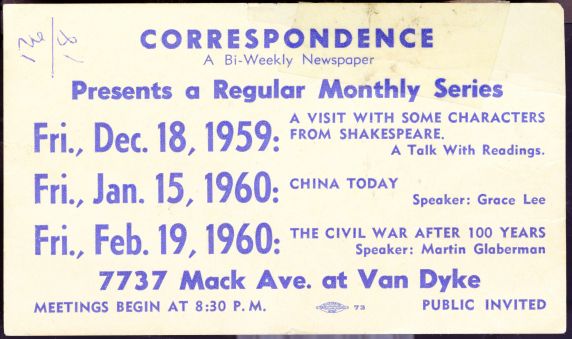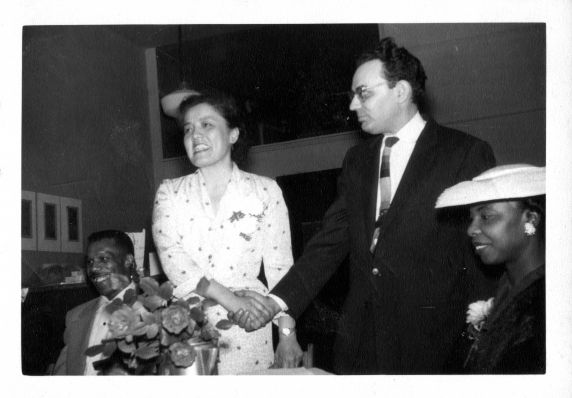The Birth, Life, and Legacy of the Johnson-Forest Tendency in the Nettie Kravitz Papers
The Nettie Kravitz Papers join several others at the Reuther Library documenting the activities of the Johnson-Forest Tendency and its members. Before Kravitz was a professor of Women’s Studies and Literature at Oakland Community College, she was a member of the Johnson-Forest Tendency and later iterations. The socialist subgroup was led by CLR James and Raya Dunayevskaya, taking its name from their respective pseudonyms, JR Johnson and Freddie Forest. The Nettie Kravitz Papers are among the most extensive records of the "Johnsonite" tradition, following the Johnson-Forest Tendency, Correspondence Publishing Committee, and Facing Reality Publishing Committee from their beginnings through bitter splits, dissolution, and legacy.
Johnson-Forest was founded as a minority faction of the American Workers Party (WP) in 1941, itself the result of a factional divide in the Socialist Workers Party (SWP). The Soviet Union's role in the war was central to the split. The party majority’s failure to condemn the USSR and the Hitler-Stalin Pact drove a minority led by Max Shachtman, CLR James, and Raya Dunayevskaya to split off to form the WP in 1940. Reuther collections the Sandford Cohl Papers, John Dwyer Papers, and Helen Schiff Papers describe this Johnson-Forest pre-history. The nature of the split complicates attitudes toward socialism that frequently oversimplify it as a set of either wholly authoritarian or purely communal values.

James and Dunayevskaya were joined by Grace Lee Boggs, forming the Johnson-Forest minority tendency of the WP. The Martin and Jessie Glaberman Papers include additional documentation on the group’s early years. Johnson-Forest and descendant organizations suffered several other splits over the 25 years that followed.
Motivated in part by James’ interest in a Black-led movement not prioritized by the WP, Johnson-Forest briefly rejoined the SWP before leaving altogether in 1950. The group reformed in 1951 as an independent organization, the Correspondence Publishing Committee. They published bulletins and newspapers with a focus on labor and leftist movements, distributing them at plants. The organization’s center was relocated from New York to Detroit in the mid-1950s to be closer to the labor movement’s hub, which brought Kravitz to the city where she spent the rest of her life. In 1955, theoretical disagreements with James led to Dunayevskaya’s departure, which marked the end of the group's namesake collaboration. Dunayevskaya then formed the News & Letters Committees, the only organization to sprout from the Johnson-Forest Tendency that still exists today. This split is particularly well documented in the Kravitz Papers, with the surrounding years (1953-1957) making up most of the collection. Dunayevskaya’s political philosophy is detailed in her writings in the Raya Dunayevskaya Papers.

Remaining members continued to operate under the Correspondence name until 1962, when Grace Lee Boggs, James Boggs, Lyman Paine, and Freddie Paine broke with James’ ideology in favor of a third worldist politics. Glaberman at least viewed the split as a shift away from the working class. The Paines’ political interests and activities during their years with Correspondence Publishing are documented in the Frances D. and G. Lyman Paine Papers. The James and Grace Lee Boggs Papers represent the couple's activities following their split. Both personal and organizational records in the Kravitz Papers outline this fracture.
Members still loyal to James' worldview, including Kravitz and Marty Glaberman, assumed the name Facing Reality Publishing Committee and continued to circulate their ideas through small radical publications. The final formation, and the most localized to Detroit, lasted until 1970 when it dissolved due to stagnating membership and disinterest among youth leading a new generation of leftist movements. Glaberman continued to circulate James’ ideas until his death in 2001, efforts that are represented in both the Kravitz Papers and Martin and Jessie Glaberman Papers.
After Facing Reality dissolved, Kravitz obtained a graduate degree from Wayne State University and taught Women’s Studies and Literature at Oakland Community College for more than 20 years. Correspondence spanning decades often double as political writings and show she maintained friendships with CLR James, Selma James, and Marty Glaberman for the rest of their lives. As one of the most extensive records of the Johnsonites, the Kravitz Papers trace a political lineage through several important figures and organizations in the labor movement.
Note: This post was authored by Leah Minadeo in Spring 2022


 Reddit
Reddit Facebook
Facebook LinkedIn
LinkedIn